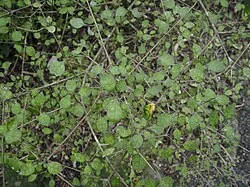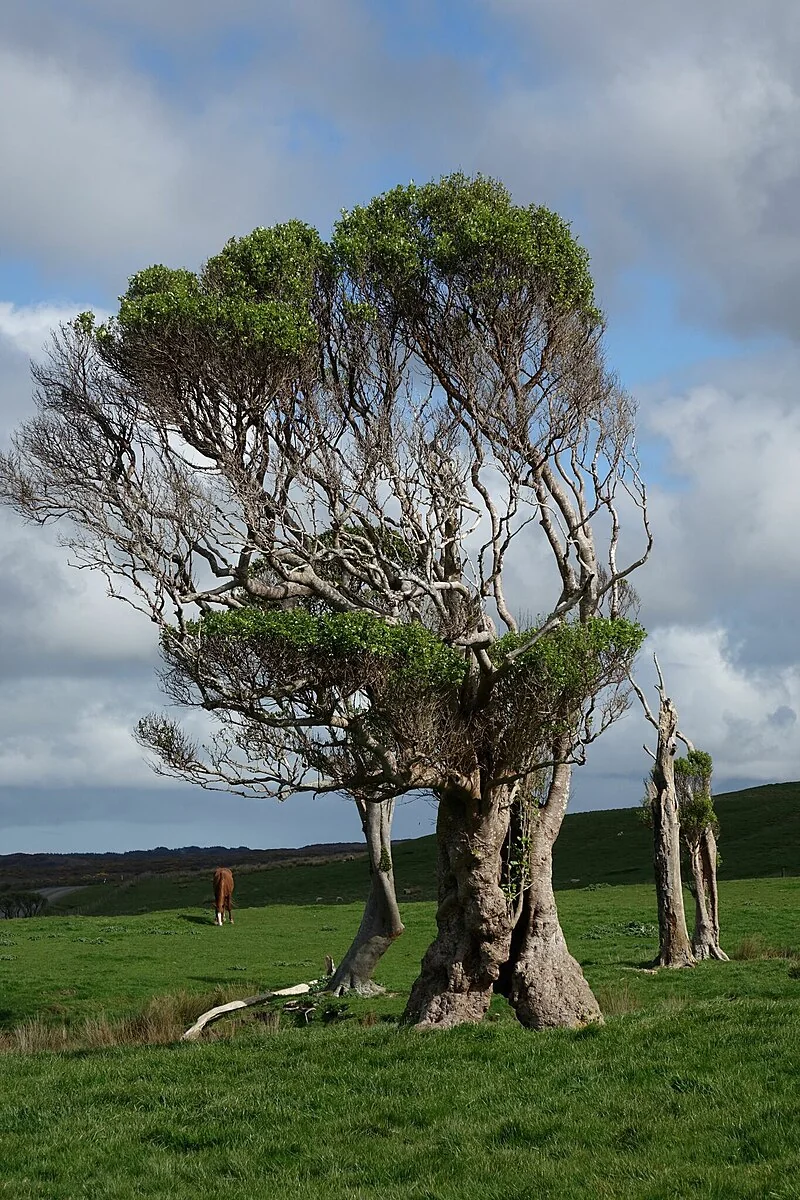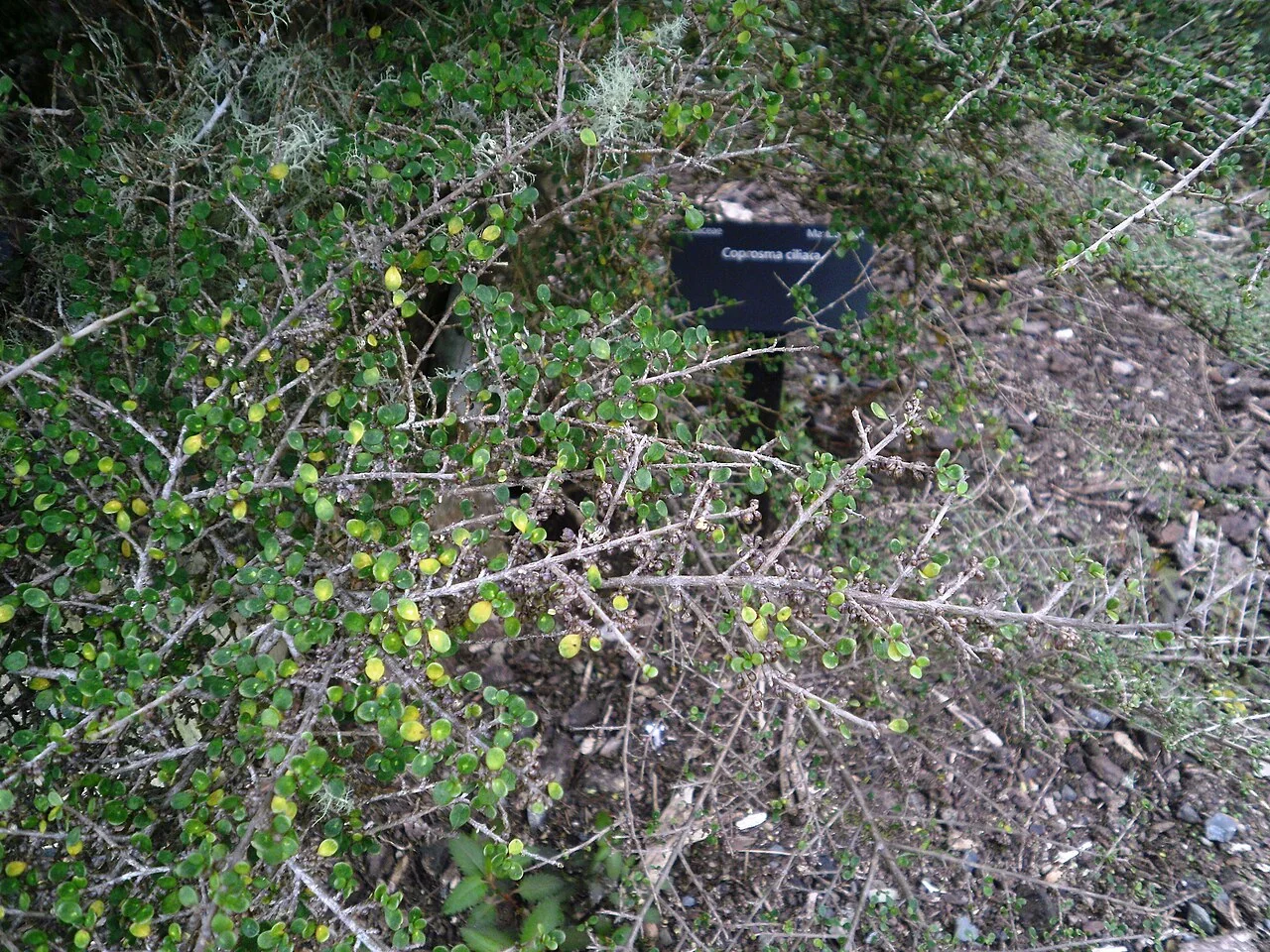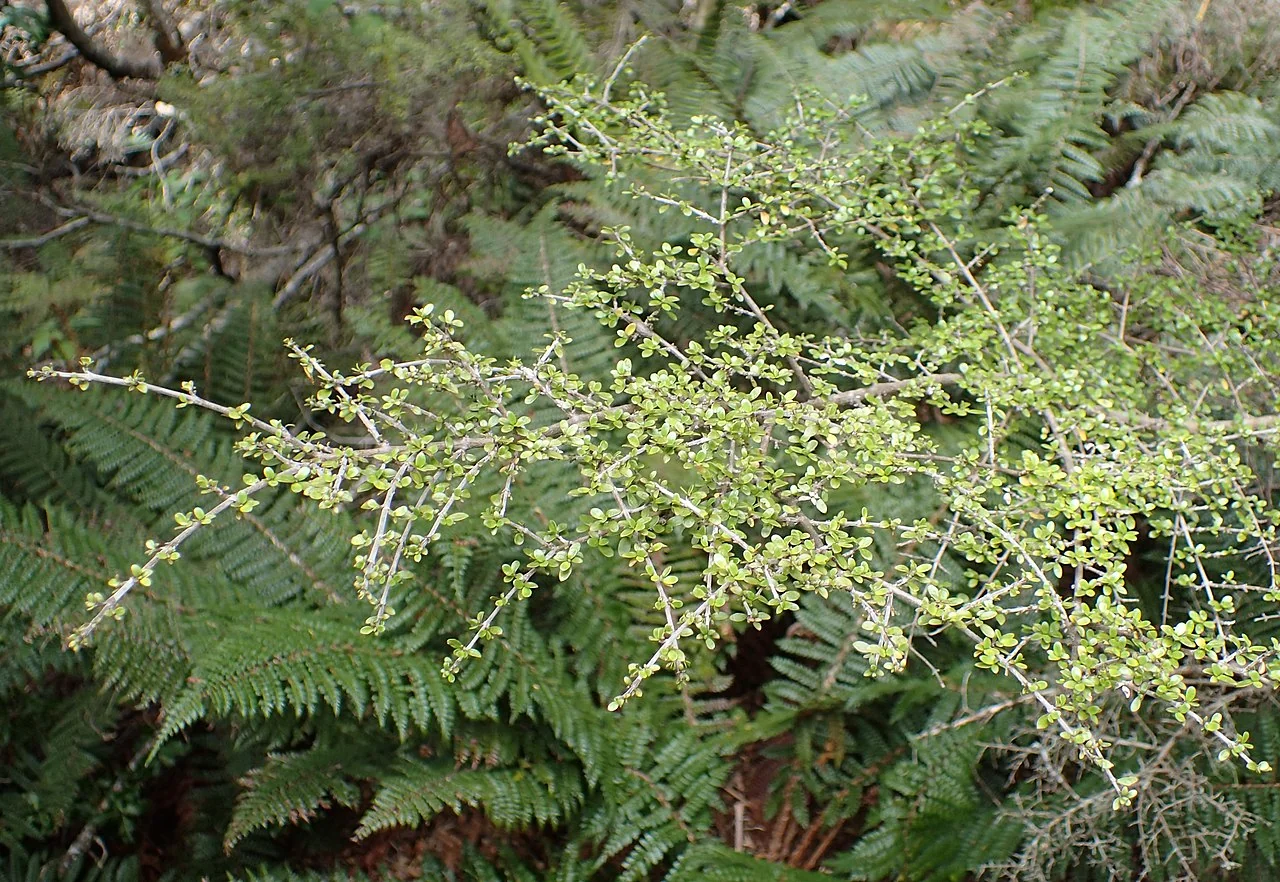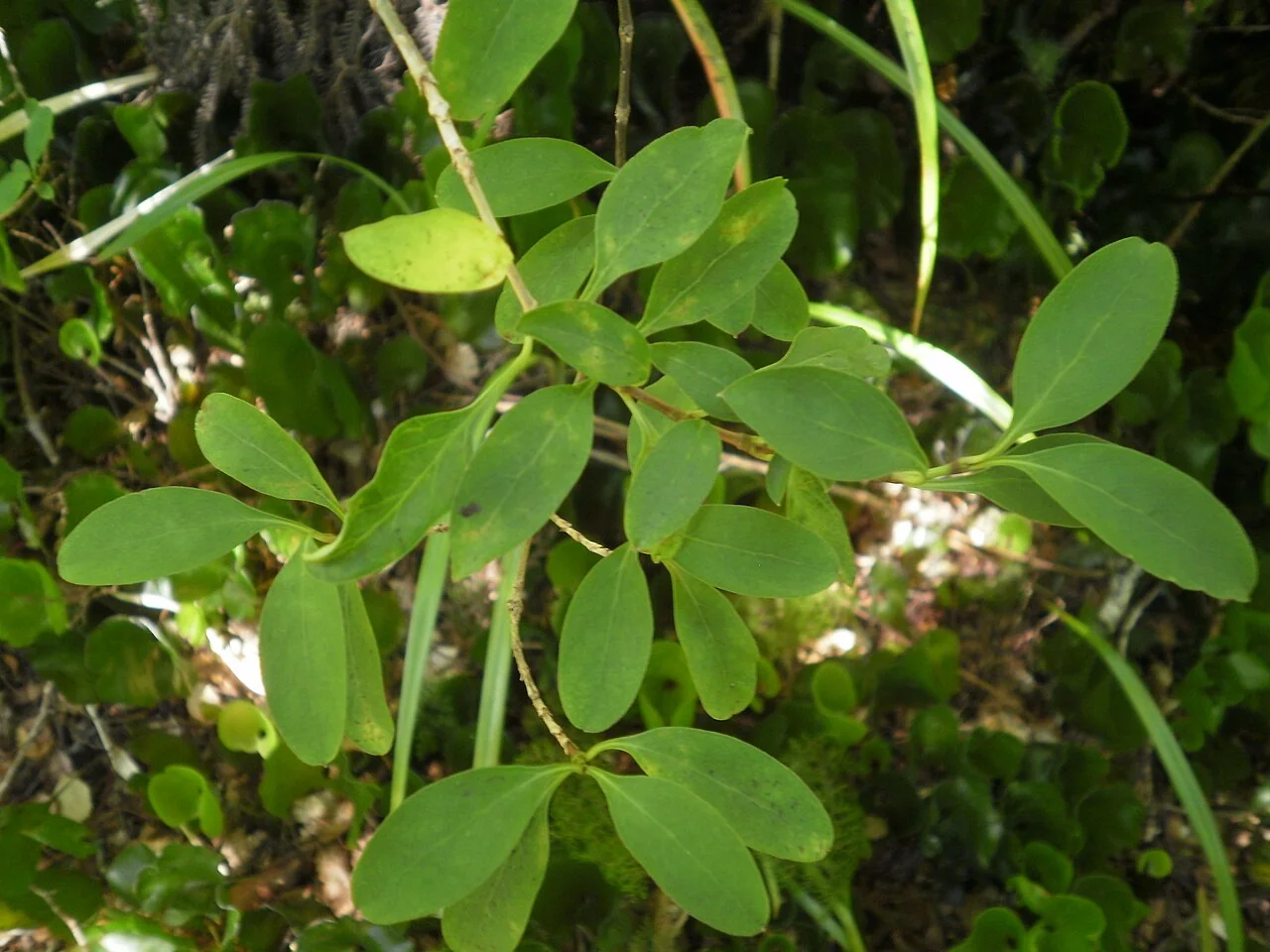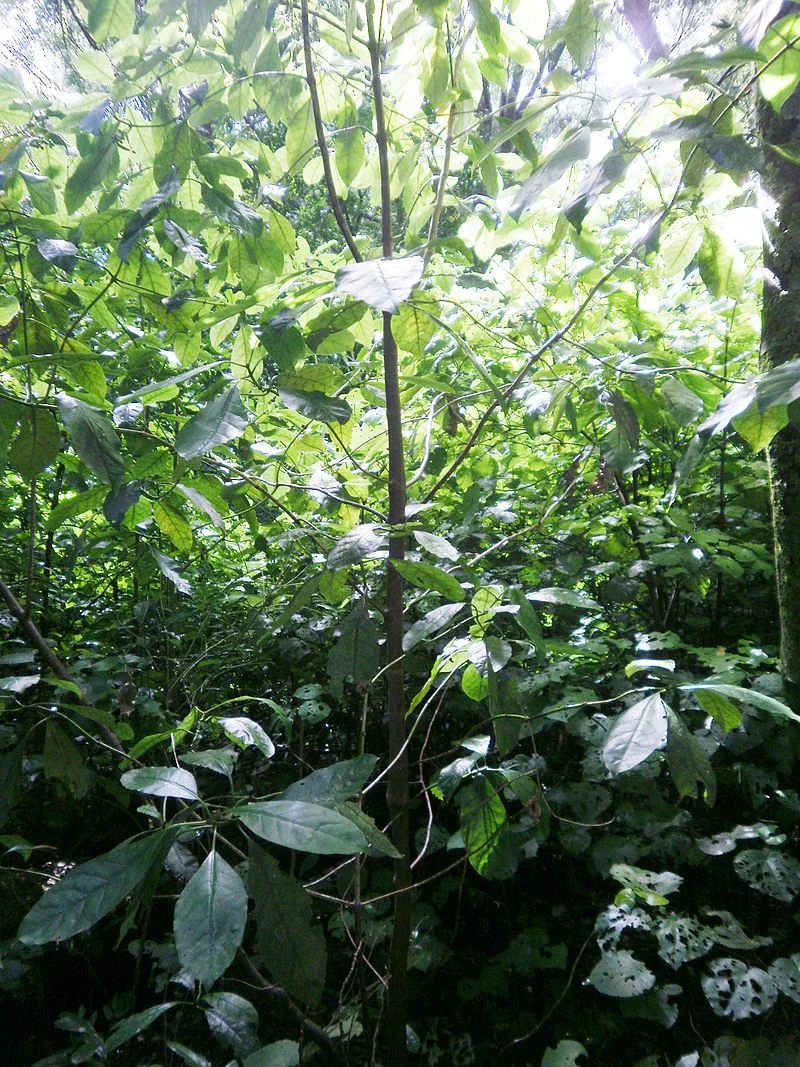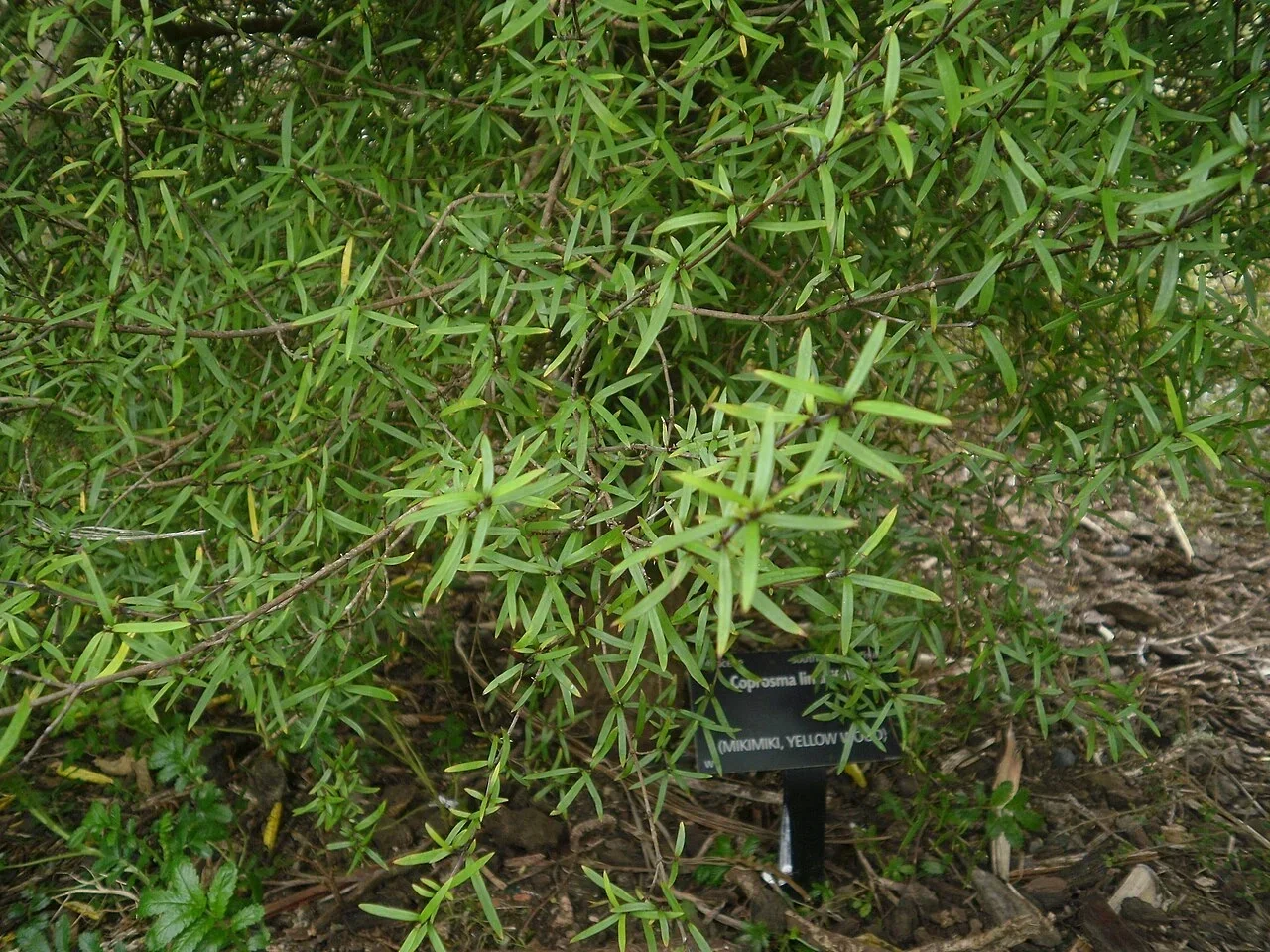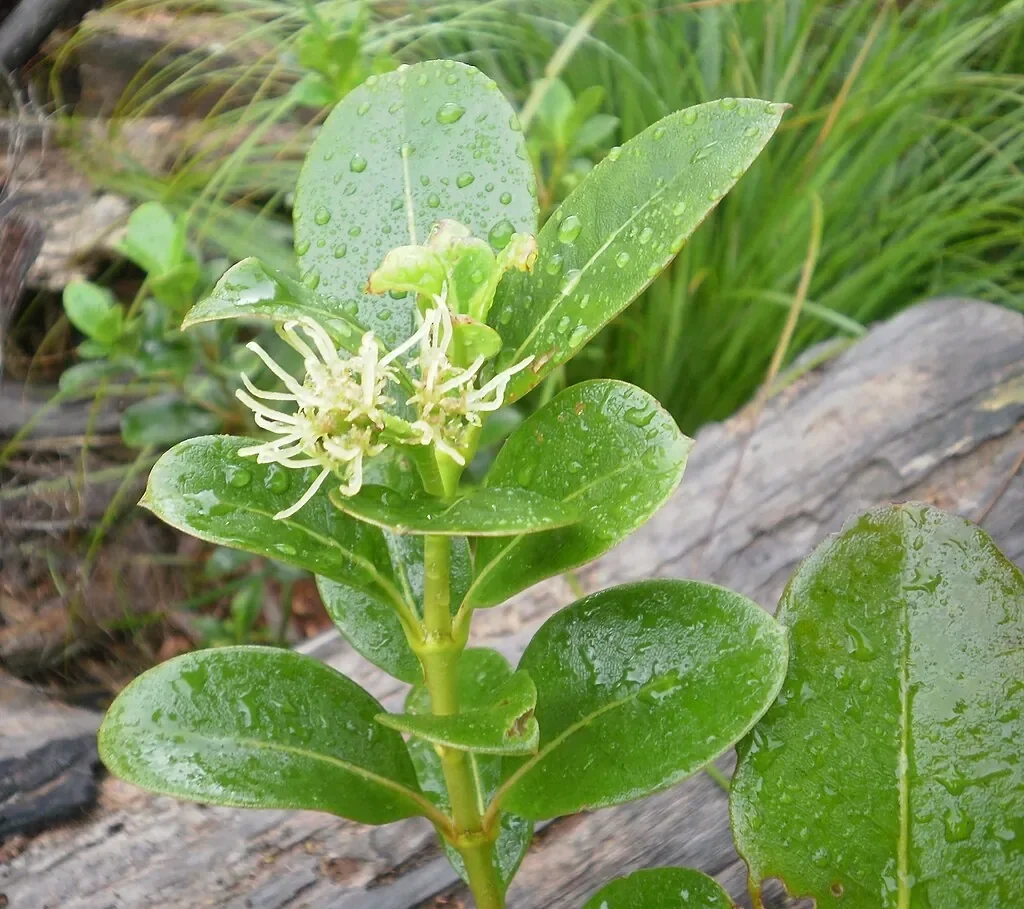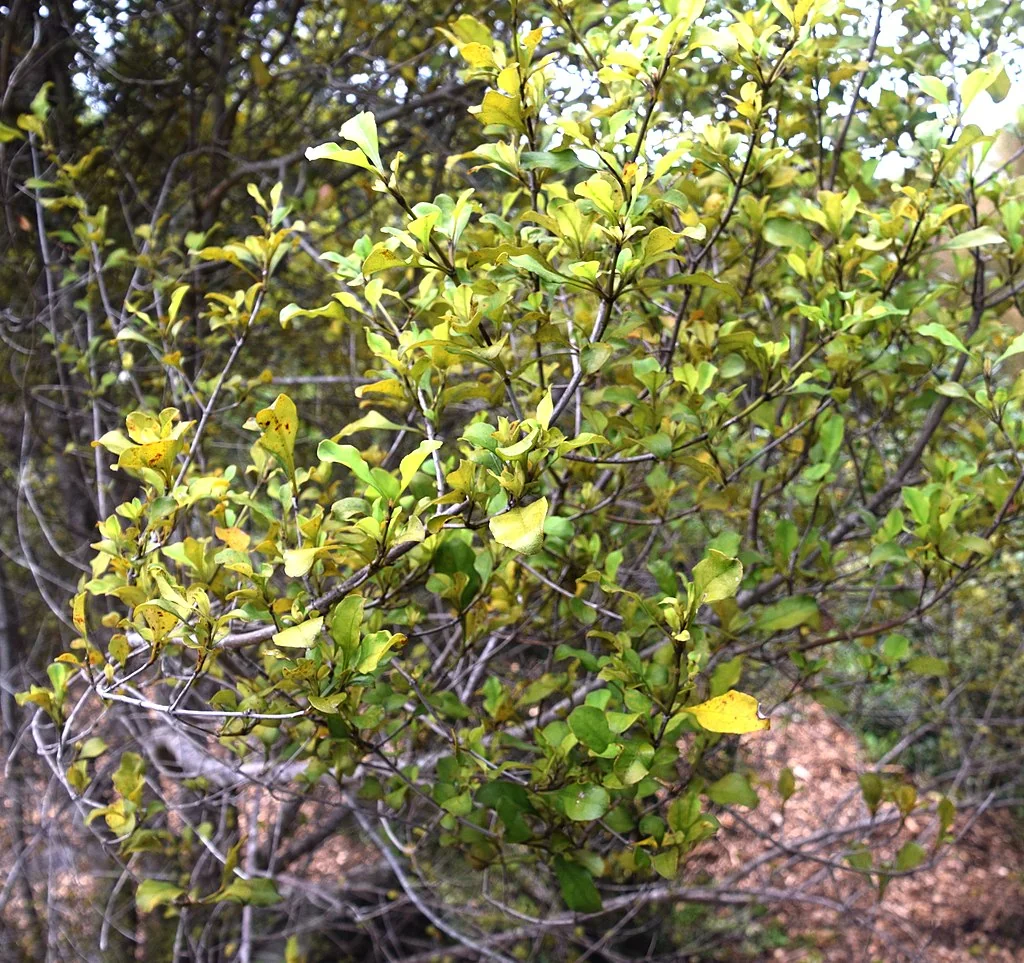
Tree Coprosma
Coprosma arborea
Coprosma arborea , also known as mamangi or tree coprosma, is a species among New Zealand's native trees endemic to New Zealand, primarily found in the upper half of the North Island and the Three Kings Islands. It is the largest species within the Coprosma genus and can grow up to 10-12 meters tall in its natural forest habitat, with a trunk diameter of 20-50 cm. The leaves are typically small, roundish, and thin, growing in pairs. Adult leaves are generally 50-80 mm by 30-48 mm, ovate to broad-elliptic or oblong, and can be yellow-green to dark green above, often mottled with maroon or purple, and pale wine-red below. The female trees produce translucent, glassy white, broad-oblong, fleshy drupes (stone fruit) that are 6-8 mm long. These fruits are non-poisonous and are a favorite food source for birds. It thrives in coastal to lower montane forests, often forming part of the sub-canopy in kauri forests or mixed pōhutukawa-hardwood forests.

Plant Description
Botanical Features
Tree Coprosma, or Mamangi ( Coprosma arborea ), is a bushy small tree endemic to New Zealand, primarily found in the upper half of the North Island and the Three Kings Islands. It is the largest species within the Coprosma genus, growing 8-12 meters tall with a trunk diameter of 20-50 cm. Its leaves are small, roundish, thin, and often mottled yellow-green, dark green, maroon, or purple, growing in pairs. The female trees produce translucent, glassy white, broad-oblong, fleshy drupes (berries) that are 6-8 mm long and are a favorite food source for birds. It thrives in coastal to lower montane forests, often forming part of the sub-canopy in kauri forests or mixed pōhutukawa-hardwood forests.
Quick Facts
Tree Summary
| Scientific Name | Coprosma arborea |
|---|---|
| Common Name | Tree Coprosma, Mamangi |
| Family | Rubiaceae |
| Height | Up to 12 m |
| Spread | 4-6 m |
| Water Needs | Moderate, tolerates some drought |
| Light | Full sun to semi-shade |
| Frost Tolerance | Hardy once established |
| Salt Tolerance | Low; requires protection from salt exposure |
| Growth Rate | Moderate to fast |
| Lifespan | Long-lived |
Climate Best Suited to
White maire (Nestegis lanceolata) is primarily found in lowland to hilly forests across the North Island of New Zealand, extending to the Marlborough Sounds in the South Island. It demonstrates good adaptability to various conditions, thriving in areas with well-drained soils and tolerating both full sun and partial shade. Its natural distribution suggests a preference for warmer, more humid environments but with a reasonable tolerance for cooler temperatures found in its southern range.
Regional Suitability
| City | Climate Suitability |
|---|---|
| Whangārei | Ideal |
| Auckland | Ideal |
| Hamilton | Ideal |
| Tauranga | Ideal |
| Rotorua | Ideal |
| Gisborne | Ideal |
| New Plymouth | Ideal |
| Napier | Ideal |
| Whanganui | Ideal |
| Palmerston North | Ideal |
| Wellington | Ideal |
| Nelson | Ideal |
| Christchurch | Ideal |
| Dunedin | Moderate |
| Invercargill | Moderate |
Natural Habitat
Typical Environments
Understand the natural habitat of Tree Coprosma ( Coprosma arborea ), including its geographical distribution, preferred environmental conditions, and the types of forest ecosystems where it thrives. This knowledge is crucial for replicating natural conditions in cultivation.
- Geographical distribution in northern North Island from sea level to 600 m elevation.
- Preferred kauri forest and mixed native forest habitats.
- Associated plant communities and typical forest companions.
Plant Conservation
Coprosma arborea, also known as mamangi or tree coprosma, is a species of tree endemic to New Zealand. Its national conservation status has consistently been assessed as "Not Threatened" in New Zealand Threat Classification System (NZTCS) assessments, including in 2004, 2009, 2012, and 2017. Regionally, for Auckland in 2025, it is also classified as "Regionally Not Threatened".
Growing Requirements
Soil Requirements
White maire (Nestegis lanceolata) is remarkably adaptable to different soil conditions, thriving in well-drained environments. It can tolerate a variety of soil types, from sandy to loamy, and prefers a neutral to slightly acidic pH. Good drainage is crucial to prevent root rot, ensuring healthy growth and development.
- Tolerates a wide range of soil types from clay to sandy
- Prefers well-draining soils but can handle occasional waterlogging
- Thrives in moderately fertile soils but will grow in poor soils too
- Can tolerate slightly acidic to slightly alkaline pH
- Handles coastal conditions including salt spray
Light Requirements
White maire (Nestegis lanceolata) thrives in a variety of light conditions, from full sun to partial shade. Optimal growth and flowering are typically achieved in locations receiving ample sunlight throughout the day. However, it can also tolerate some shade, especially in hotter climates, where it benefits from protection during the most intense afternoon sun.
- Full sun for optimal growth and form
- Can tolerate partial shade but may develop a leggier form
- At least 6 hours of direct sunlight daily is ideal
- Northern or eastern exposures work well in garden settings
Water Requirements
Once established, White maire (Nestegis lanceolata) is remarkably drought-tolerant, requiring minimal supplemental watering. During its establishment phase, consistent moisture is crucial to encourage strong root development. Mature plants can withstand dry periods, but regular watering during prolonged droughts will promote healthier growth and more abundant flowering.
- Moderate watering during establishment (first 1-2 years)
- Drought-tolerant once established
- Can handle periods of soil saturation
- Reduce watering in winter when growth slows
- Signs of overwatering include yellowing leaves and crown rot
Planting Guide
-
Best Time to Plant
The best time to plant Tree Coprosma is in autumn or spring, when the soil is moist and temperatures are mild. This allows the tree to establish before facing summer heat or winter cold.
-
Choosing a Location
Select a site with well-drained soil in sun or semi-shade. Allow enough space for the tree to reach its mature size. It is a great choice for a specimen tree or as part of a mixed native border.
-
Planting Steps
Dig a hole twice the width of the pot. Add some compost to the soil. Place the plant in the hole, making sure it is at the same depth as in the pot. Backfill with soil, firm gently, and water thoroughly.
Ecological Significance
Ecosystem Roles
Tree Coprosma ( Coprosma arborea ) plays a vital role in northern North Island forest ecosystems, serving as both a crucial food source for native wildlife and an important structural component of kauri forest communities.
- Orange berries provide essential food for native birds including kererā, tāā, and bellbirds
- Flowers attract native pollinators and beneficial insects throughout the flowering season
- Provides habitat and shelter for forest insects and invertebrates
- Important component of kauri forest understory and mixed native forest communities
- Helps stabilize forest soils and supports overall ecosystem health
Uses and Significance
Garden Uses
- Specimen tree for visual impact
- Suitable for native gardens and restoration projects
- Enhances native garden aesthetics and biodiversity
- Provides architectural accent with its unique structure
- Effective for erosion control on slopes and banks
Ecological Value
Ecologically, White maire (Nestegis lanceolata) plays a crucial role in supporting native ecosystems. Its fruits are a food source for birds, especially the kereru, contributing to the local biodiversity and food web.
- Provides a vital food source for native birds, especially the kereru
- Offers habitat and nesting sites for various fauna
- Contributes to soil stabilization and nutrient cycling
- Forms natural shelter belts, protecting other species
Landscaping Applications
Discover how Tree Coprosma ( Coprosma arborea ) can be effectively integrated into various landscaping designs. This section offers creative ideas and practical advice for using this attractive native tree to enhance the beauty and ecological value of your outdoor spaces.
- Design ideas for native forest gardens and naturalistic landscapes.
- Best uses as specimen trees and in mixed native plantings.
- Combining with other native species for authentic forest communities.
Seasonal Care Calendar
Spring
In spring, White maire (Nestegis lanceolata) begins its active growth phase. New foliage emerges, and it's an ideal time for planting new specimens or propagating. Ensure adequate moisture and monitor for early signs of pests.
- New growth begins with fresh foliage development
- Apply a balanced, slow-release fertilizer if desired
- Excellent time for planting new specimens or dividing offsets
- Monitor for new pest activity and address promptly
Summer
Summer is the peak growing season for White maire (Nestegis lanceolata), often accompanied by flowering. Consistent watering is important, especially for young plants, to support vigorous growth and prevent stress during dry periods.
- Flowering typically occurs in early to mid-summer (November-January)
- Water young trees regularly during extended dry periods
- Avoid heavy pruning during the active growing season
Autumn
During autumn, White maire (Nestegis lanceolata) prepares for the cooler months. Fruits or berries develop, providing food for native birds. It's also a good time for planting and general garden cleanup.
- Fruits or berries develop and ripen (December-February), attracting birds
- Natural leaf shedding occurs as part of its growth cycle
- Good time for planting new specimens to establish before winter
- Clean up fallen leaves if a tidy appearance is desired
Winter
Winter is generally a dormant period for White maire (Nestegis lanceolata). Minimal care is required, though young plants may benefit from protection in colder regions. This is an opportune time for any necessary structural pruning.
- Generally dormant with minimal growth activity
- No special winter protection needed in most mild climates
- Suitable time for structural pruning if required
- Fallen leaves can be left as mulch or removed for tidiness
When to Prune and How Much
White maire (Nestegis lanceolata) generally requires minimal pruning to maintain its natural form and health. Pruning should focus on removing dead or damaged growth and shaping the plant as needed.
- Remove dead, damaged, or diseased branches at any time of year
- Light formative pruning when young helps establish good structure
- To create a multi-trunked specimen, cut the main stem to encourage branching
- Fallen leaves can be removed for a tidier appearance, or left as natural mulch
- If necessary, lower branches can be removed to create clearance underneath
- Major pruning is best done in late winter to early spring before new growth
Always use clean, sharp tools for pruning to minimize the risk of disease and ensure clean cuts. The plant often responds well to pruning with vigorous new growth, contributing to a fuller, healthier appearance.
How to Grow Tree Coprosma
From Fresh Berries
Fresh berry propagation represents the most reliable and efficient method for growing Tree Coprosma, taking advantage of this forest species' natural reproductive strategy while ensuring optimal germination rates through proper seed processing techniques. This majestic northern native produces abundant translucent, glassy white berries containing two small seeds that provide excellent opportunities for large-scale propagation essential for restoration projects and forest establishment. The species' role as a crucial food source for native birds means that berry collection timing must balance human propagation needs with wildlife feeding requirements, demonstrating the interconnected nature of forest ecosystem management. Fresh berries provide significantly higher germination success compared to stored seeds, making immediate processing and sowing the preferred approach for both commercial and conservation propagation programs. Collect ripe berries during autumn when they naturally fall or can be easily picked from branches, timing collection to coincide with peak ripeness when seeds have achieved maximum viability without delaying so long that birds consume the entire crop. Choose berries that are fully developed, translucent, and slightly soft to touch, avoiding any that show signs of damage, disease, or premature dropping that might indicate poor seed quality or viability problems. Process berries immediately after collection by removing all flesh through thorough washing, using gentle rubbing and multiple rinses to eliminate all fruit material that could inhibit germination or promote fungal growth during the germination process. Separate seeds from pulp by placing berries in water and gently mashing to release seeds, then washing away fruit debris while retaining the small, dark seeds that sink to the bottom of washing containers. Prepare optimal germination medium using well-draining seed-raising mix with excellent moisture retention characteristics, incorporating organic matter and ensuring pH levels between 6.0-7.0 that support healthy seedling development for this forest species. Sow fresh seeds immediately after processing, placing them 5mm deep in moist growing medium while maintaining consistent moisture throughout the germination period without creating waterlogged conditions that can prevent successful emergence. Provide optimal environmental conditions including consistent temperatures between 15-20°C and bright, indirect light that replicates the filtered forest conditions where this species naturally regenerates under mature canopy cover. Maintain careful moisture management throughout the 4-8 week germination period, ensuring growing medium remains consistently moist but never saturated while monitoring for early signs of seedling emergence. Young seedlings develop moderate growth rates while establishing the root systems necessary for eventual forest canopy development, requiring protection from direct sunlight and environmental stress during early establishment phases. Transplant successful seedlings when they reach 5-10cm height and have developed sufficient root systems to handle garden conditions, providing optimal growing environments that support the transition from nursery to permanent planting locations.
From Semi-Hardwood Cuttings
Semi-hardwood cutting propagation offers a valuable vegetative method for growing Tree Coprosma that preserves the exact genetic characteristics of superior parent plants while providing reliable results for experienced propagators working with forest restoration and conservation projects. This approach is particularly beneficial for maintaining exceptional specimens that demonstrate superior growth characteristics, disease resistance, or adaptation to specific environmental conditions that can be preserved through careful vegetative propagation techniques. The method works well with Tree Coprosma because of the species' natural ability to develop adventitious roots when growing conditions favor vegetative reproduction, making it suitable for both commercial and conservation propagation programs. Take semi-hardwood cuttings during late summer to early autumn when current season's growth has achieved optimal maturity for rooting while retaining sufficient vigor for successful establishment under controlled propagation conditions. Select healthy, vigorous shoots from the middle portions of branches that show the characteristic pale bark and fiddle-shaped leaves typical of healthy Tree Coprosma development, avoiding both very soft growth and completely hardened wood that may be resistant to rooting. Cut sections 10-15cm in length with clean, sharp secateurs, ensuring each cutting includes at least 2-3 nodes while selecting material that represents the best characteristics of the parent plant including robust growth habit and healthy foliage development. Remove lower leaves carefully to reduce transpiration stress while retaining sufficient photosynthetic capacity in upper leaves, taking care not to damage the distinctive fiddle-shaped foliage that characterizes this species and provides energy for root development. Apply rooting hormone powder or solution immediately after preparation, using formulations appropriate for semi-hardwood cuttings to enhance root initiation while ensuring even coverage of cut surfaces where new roots will develop. Insert prepared cuttings into well-draining cutting mix composed of equal parts quality propagation medium and coarse sand, ensuring excellent drainage while maintaining the consistent moisture levels essential for successful root development without creating waterlogged conditions. Maintain optimal environmental conditions including high humidity (75-85%) and consistent temperatures around 18-20°C using humidity domes, misting systems, or other controlled environment techniques that support root development while preventing cutting stress. Provide bright, indirect light that supports photosynthesis without causing excessive transpiration stress, replicating the filtered forest conditions where this species naturally thrives as a forest understory tree. Monitor cutting development throughout the 8-12 week rooting period, maintaining consistent environmental conditions while watching for signs of root development including new shoot growth and resistance when gently tugged. Root development occurs gradually as cuttings establish the extensive root systems necessary for supporting the eventual tree-sized growth characteristic of mature Tree Coprosma specimens in forest environments. This method provides excellent results for experienced propagators seeking to maintain specific genetic lines while contributing to conservation and restoration efforts that preserve the genetic diversity essential for healthy forest ecosystems.
From Forest Restoration
Forest restoration establishment provides a comprehensive approach to growing Tree Coprosma that focuses on recreating authentic kauri forest and mixed native forest communities while contributing to large-scale ecosystem restoration and conservation efforts. This method is particularly valuable for restoration projects that aim to reestablish the northern North Island forest ecosystems where this species plays crucial ecological roles as both wildlife food source and forest structural component. Tree Coprosma serves as an essential element in authentic forest restoration, providing food for native birds through its translucent berries while contributing to the understory structure that supports diverse forest communities. Begin by identifying suitable restoration sites that provide the environmental conditions typical of this species' natural habitat, including protection from extreme weather, adequate moisture availability, and soil conditions that support forest development over extended time periods. Design restoration plantings that incorporate Tree Coprosma as part of diverse forest communities, combining it with appropriate companion species such as kauri, puriri, and other northern forest natives to create authentic ecosystem relationships. Source plant material through a combination of locally-grown seedlings, fresh berry propagation, and cutting-grown specimens to ensure genetic diversity and adaptation to local environmental conditions that support long-term forest establishment success. Prepare restoration sites by removing invasive vegetation, improving soil conditions through organic matter incorporation, and creating appropriate planting positions that accommodate the mature size and growth requirements of forest trees. Establish initial plantings during optimal seasonal windows in autumn or spring when moisture levels and temperature conditions support rapid establishment before plants face environmental stress from summer heat or winter cold. Space plantings according to forest development goals, with closer spacing for rapid canopy closure and wildlife habitat development, or wider spacing to allow natural forest succession processes to fill gaps over time. Create diverse forest structure by varying planting positions according to mature tree size requirements, placing Tree Coprosma in positions where it can develop its characteristic understory role while supporting the overall forest community development. Integrate with complementary native species that historically occurred in kauri and mixed native forests, creating plant communities that provide enhanced wildlife habitat, soil stability, and authentic forest ecosystem functions. Monitor establishment success and provide appropriate maintenance including weed control, supplemental watering during dry periods, and protection from browsing animals that could damage developing forest communities. Allow natural forest processes including seed dispersal, natural regeneration, and succession to enhance initial plantings, creating dynamic forest communities that evolve over time while maintaining the essential ecological functions that Tree Coprosma provides in northern New Zealand forest ecosystems. This approach requires longer time commitments and more intensive management compared to individual tree planting, but creates resilient and sustainable forest systems that provide lasting environmental benefits including wildlife habitat, carbon sequestration, and authentic landscape restoration.
Pests and Diseases
Tree Coprosma ( Coprosma arborea ) is generally a very hardy and disease-resistant tree with excellent natural resilience. Most problems are easily prevented with appropriate growing conditions.
Occasional Issues
- Scale insects: May occasionally occur, but usually controlled by natural predators
- Aphids: Rare, but can appear on new growth in spring
- Fungal problems: Very rare, mainly associated with poor drainage
Environmental Stressors
- Poor drainage: Can lead to root rot in heavy, waterlogged soils
- Severe drought: Young plants may suffer in extended dry periods
- Frost damage: Young plants can be damaged by severe frosts
Prevention
The key to success is providing good drainage, adequate moisture during establishment, and protection from extreme weather for young plants. Healthy trees in suitable conditions rarely have serious problems.
Cultural Significance
Tree Coprosma, known as Mamangi by Māori, holds cultural significance as a traditional food source and an indicator of fertile land. Its sweet orange berries were a favored food, especially for children. The presence of Mamangi also signaled good, productive soil, guiding traditional land management practices. This highlights its role in both sustenance and ecological knowledge within Māori culture.
Bonus Tip
Tree Coprosma (Coprosma arborea), also known as Mamangi, is an excellent choice for attracting native birds to your garden. Its abundant orange berries are a favorite food source for species like kererā, tāā, and bellbirds, especially during autumn and winter when other food sources may be scarce. Planting this tree not only adds a beautiful native specimen to your landscape but also provides vital sustenance for New Zealand's unique birdlife.
